If you’ve ever been in the middle of nowhere, you know how hard it can be to get online in times of need. You might be on a camping trip, lost your way, and want to check in with your friends or family back home. But emergencies apart, you may only want to post your dog’s interesting findings on Instagram while out hiking.
Whatever the reason, middle of nowhere internet is pretty much possible, despite how odd it may sound. For example, if you’re in the middle of a vast desert, a satellite internet connection is your best bet.
However, there are a few other ways to get connected to the internet in the middle of nowhere, depending on your situation. Let’s explore them further.
Can You Get Internet in the Middle of Nowhere?
The answer is yes and no. If you’re in the middle of a big city, it’s easy to get internet access through public wi-fi, your mobile data plan, or even at a cafe or library. But if you’re truly in the middle of nowhere – like, in the desert or up in the mountains – your options are a bit more limited.
But that doesn’t mean you’re totally out of luck. There are still a few ways you can get internet in the middle of nowhere; it just might take a little more effort and maybe even some money.
How to Get Internet in the Middle of Nowhere?
So, how do you get internet in the middle of nowhere? It doesn’t have to be that hard unless you go too far off the grid. Let’s show you some ways. We’ll begin with the most common and end with the most extreme.
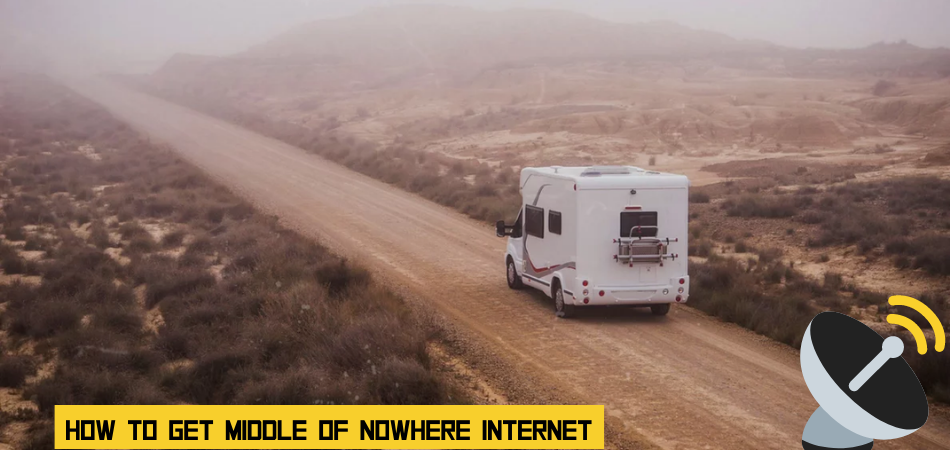
1. Use Your Phone as a Hotspot
This is probably the simplest way to get internet in the middle of nowhere – if you have cell service, that is. Just turn on your phone’s hotspot feature, and voila, you have a personal wi-fi network that you can connect your laptop or other devices too.
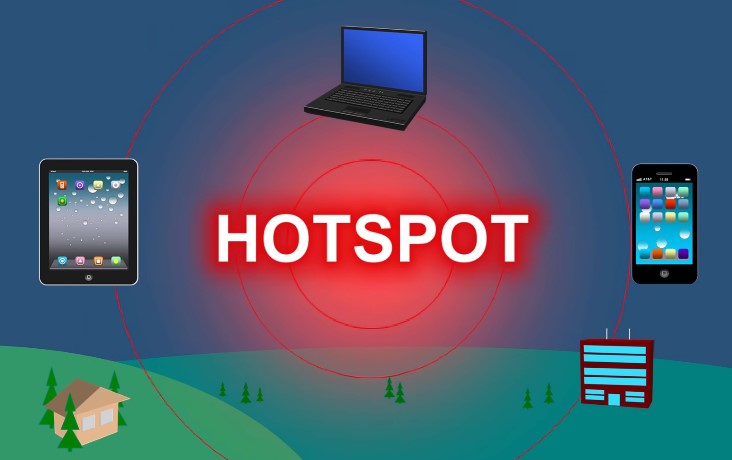
Of course, this only works if you have cell service in the first place. This method is unlikely to work if you’re in a remote area with no cell towers. Yet, you can take advantage of the high-strength signals of today’s LTE networks to get the internet in more places than ever before.
For example, if you’re in the middle of the woods, you can try tying up your cellphone to a large tree. The higher up your phone is, the better chance it has of catching a signal. If you had connected it to another phone via hotspot beforehand, chances are you can get at least some form of internet connection in the middle of nowhere.
2. Get a Data Plan for a Signal Booster
Another option is buying an unlimited data plan from one of the major carriers like AT&T or T-Mobile and using a signal booster. A signal booster is an amplifier that takes the weak signal from your phone and amplifies it, giving you better reception.
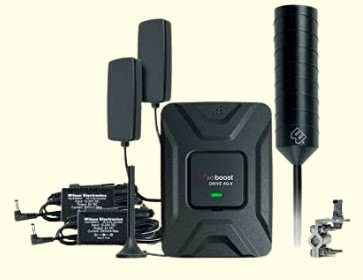
For example, the we Boost Drive 4G-X cell phone signal booster can increase your signal by up to 32 times, meaning you can get a decent internet connection in most rural areas.
The downside is that this method can be expensive since the data consumption is far higher than it would be at home due to the signal amplification, further in the middle of nowhere. And, of course, it’ll drain your phone’s battery faster. But if you’re going to be in a remote area for an extended period, this might be the best option.
3. Use a Wireless Air Card
A wireless air card is a device you can insert into your laptop’s USB port to get internet access. It’s basically like a mobile hotspot, but it’s a bit more expensive.
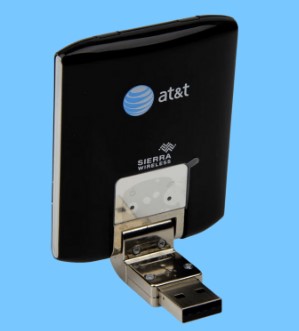
The main advantage of a wireless air card is that it’s very portable and easy to use. You can just plug it into your laptop, and you’re good to go. And since it uses the same cell towers as your phone, you’ll usually get pretty good speeds – assuming you have cell service, of course.
A wireless air card can cost anywhere from $50-$100, depending on the carrier and the data plan. But if you’re going to be in a remote area for an extended period, this might be the best option.
4. Connect at an RV Park or Campground
RV parks are the easiest way to go online while traveling. Most parks offer Wi-Fi and cable TV hookups, but you’ll have to pay a daily fee for access. The good news is that it’s usually cheaper than paying for both at home.
If you’re a member of an RV club, like Escapees or Good Sam, sign up for their services first. They will often provide discounts on park fees through their discount programs.
Campgrounds are another good choice if you want to get online while traveling with an RV or camper trailer. Most campgrounds offer free Wi-Fi access on most sites, although some charge extra for this service if there are not enough available connections in the area where you want to camp.
5. Try DSL
DSL or Digital Subscriber Line used to be the most common broadband internet connection in earlier generations. It may be an older technology, but it’s still fine for many people. It works by sending data over your phone line, and it can be slower than cable modems and fiber services.
DSL comes in two flavors: ADSL and SDSL. ADSL is older and slower, while SDSL is newer and faster.
If you’re going with DSL, make sure you have an active telephone line (maybe in your remote house or car) before calling your local provider. Some providers will only provide service if you have a landline installed at your house though others will let you use a cell phone.
As an alternative to a landline, you can try asking friends, neighbors, or people living nearby if they’d be willing to share their line with you—some might not mind letting you piggyback on their account as long as they don’t notice any problems with their own service.
If everyone else nearby has DSL, too, this probably won’t be an issue—but if not, check out other options in this article.
6. Get a Satellite Internet Connection
If you’re really in the middle of nowhere, then chances are there is no cell service either. In that case, your best bet is to get a satellite internet connection. This involves setting up a dish that connects to a satellite in orbit and gives you broadband speeds.
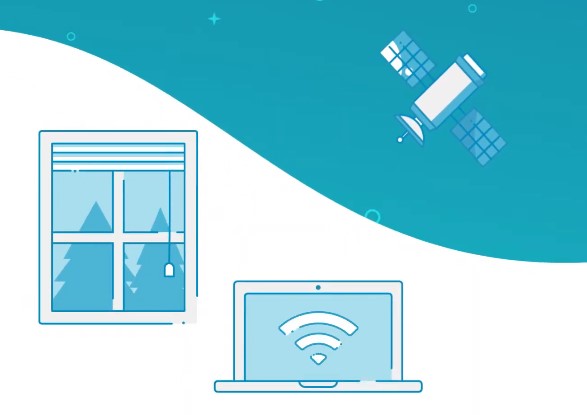
Elon Musk’s company, SpaceX, is currently working on Starlink’s satellite-based internet service. But it’s pricy (around $300-$500 per month) and not available everywhere just yet. But where available, it can provide astounding speeds of up to 500 Mbps. So, if you were wondering- ‘Does Wi-Fi work without electricity?’ this might be your best answer.
Another option is Viasat, which offers satellite internet plans starting at $150 per month. Again, you’ll need to have a dish installed, but the speeds are pretty good – up to 100Mbps in some areas.
Of course, satellite internet is not perfect, mainly because of limited region coverage and high fees. The speeds can be a bit slow, and the latency (the time it takes for data to travel from your device to the satellite and back) can be high. But if you’re in a remote area with no other options, it’s definitely worth considering.
7. Use a MiFi Device
A MiFi device is basically a portable hotspot. It’s a small device that you can carry with you and connect your devices to the internet via Bluetooth or Wi-Fi.
MiFi devices are very convenient because they’re small and easy to use. And since they create their own wi-fi network, you can connect multiple devices to them simultaneously.
These devices usually cost around $100 and come with their own data plans, so you need to sign up for one. But the good news is that they’re usually pretty affordable – around $50 per month or so.
And since they’re portable, you can take them with you wherever you go. It’s definitely worth considering a MiFi device if you’ll be spending a lot of time in a remote area.
How Do You Get WiFi in the Middle of the Woods?
In the middle of the woods, your best bet is to get a satellite internet connection. However, if that’s beyond your budget, you can also try using a MiFi device or a wireless air card. And if that too is not an option, you can always try your luck with the good old-fashioned cell phone data plan.
But what if you have no feasible way of getting internet access in the middle of the woods? Well, in that case, you’ll just have to make do with whatever you can find. One of the innovative options is building a powerful wi-fi antenna to get internet from a faraway source.
The idea may sound like something out of a science fiction novel, but it is actually possible. All you need is a bit of creativity and the right tools. Check out this link to see how this guy made a long-range wireless antenna out of mere household items.
Conclusion
So, after reading this article, you should know by now that there are several ways to make the middle of nowhere internet a reality for you.
Hopefully, we’ve helped you think about your needs and how you want to connect in the future. Don’t forget that even when there’s no internet available, a phone call or text is still possible.
But wherever you are and whatever situation you’re in, we’re confident that one of these methods can get you connected.
